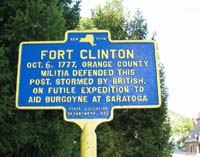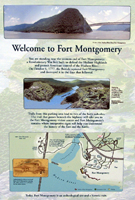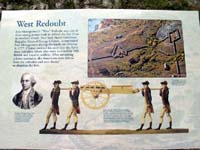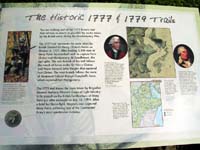| Things To Do Kids | ||

|
||
Orange CountyAmerican Revolution | American War of Independence |
|
All Fort Montgomery ListingsFort Montgomery American Revolution | American War of Independence |
|||
| 845-446-2134 | ||
|
Battles of the American Revolution
Battle of Fort Montgomery and Battle of Fort Clinton Date: October 3, 1777 Between: British, German (Hessian), and Loyalist troops against American Continental Army Location: Fort Montgomery and Fort Clinton in Bear Mountain  more . . .
more . . .
| |||
| 845-446-2134 | ||
|
Battles of the American Revolution
Battles of Fort Clinton and Fort Montgomery Date: October 3, 1777 Between: British, German (Hessian), and Loyalist troops against American Continental ArmyLocation: Fort Clinton and Fort Montgomery in Bear Mountain Click to enlarge sign at Fort Clinton.
 more . . .
more . . .
| |||
| |||
|
Click to enlarge the sign Chaining the Hudson in the American Revolution. 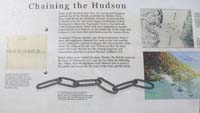 The sign reads:
The sign reads:
Chaining the Hudson "Early in the Revolutionary War, the Continental Congress realized that if the British controlled the Hudson River, they could divide the rebellious colonies. To prevent this, in March 1776, the Americans began construction of Fort Montgomery above the Popolopen Creek on the west side of the Hudson River. Their work soon expanded to include a second fort, Fort Clinton, on the south side of the creek, and a massive iron chain that stretched across the Hudson River.  photos, website and more . . .
photos, website and more . . .
| |||
| 845-446-2134 | ||
 photos, website and more . . .
photos, website and more . . .
| |||
| 845-446-2134 | ||
Click
to enlarge photo of Fort Montgomery Chain.
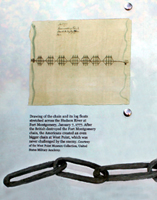 The sign reads:
The sign reads:
"Drawing of the chain and its log floats stretched across the Hudson River at Fort Montgomery, January 7, 1777. After the British destroyed the Fort Montgomery chain, the Americans created an even bigger chain at West Point, which was never challenged by the enemy. Courtesy of the West Point Museum Collection, United States Military Academy." Press blue button to learn more about the American Revolution in the Hudson Valley.  website and more . . .
website and more . . .
| |||
| 845-446-2134 | ||
 website and more . . .
website and more . . .
| |||
| 845-446-2134 | ||
 website and more . . .
website and more . . .
| |||
| |||
Click
to enlarge photo of Map of Hudson River Chain.
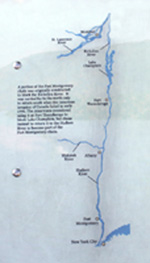 The sign reads: "A portion of the Fort Montgomery chain was origninally constructed to block the Richelieu River. It was carried far to the north only to return south when the American invasion of Canada failed in early 1776. The Americans considered using it at Fort Ticonderoga to block Lake Champlain, but chose instead to return it to the Hudson River to become part of the Fort Montgomery chain."  website and more . . .
website and more . . .
| |||
| |||
|
Click to enlarge photo of Popolopen Suspension Footbridge.  Popolopen Creek
Popolopen Creek
Popolopen Creek is a stream, mostly fed by Lake Popolopen, Stillwell Lake, and Weyant's Pond, that drains into the Hudson River. In 2002, New York's Governor George Pataki, dedicated a long suspension footbridge that spans Popolopen Creek. The footbridge connects the trail between the twin forts of Fort Montgomery and Fort Clinton, carrying the Appalachian Trail across Popolopen Creek.  more . . .
more . . .
| |||
All New Windsor ListingsNew Windsor American Revolution | American War of Independence |
||
| 845-561-1765 | |
|
New Windsor Cantonment State Historic Site is located at 374 Temple Hill Road, New Windsor, NY 12553 in Orange County.
From New Windsor Cantonment: "New Windsor Cantonment State Historic Site is where the Continental Army under General George Washington spent the last winter and spring of the Revolutionary War. In October 1782, General Washington moved his northern army to New Windsor to establish winter quarters. Some 7,500 soldiers and 500 women and children civilian refugees encamped here. By late December 1782, they had erected nearly 600 log huts into a 'cantonment,' a military enclave. It was at the New Windsor Cantonment that the cease fire orders were issued by Washington ending the eight-year War of Independence on April 19, 1783."  website and more . . .
website and more . . .
| ||
All City of Newburgh ListingsCity of Newburgh American Revolution | American War of Independence |
||
| 845-562-1195 | |
|
Washington's Headquarters State Historic Site is located at 84 Liberty Street, Newburgh, NY 12551 in Orange County.
"Visit the nation's first publicly owned historic site and tour the rooms where American history was made. In the critical months that General George Washington spent at Newburgh, he made some of his most important contributions to shaping the American republic. It was here that Washington rejected the idea that he should be king after the war; ended the Newburgh conspiracy, preventing military control of the government; created and awarded the Badge of Military Merit, forerunner of the Purple Heart; and circulated a letter to State Governors that influenced the writing of the Constitution."  website and more . . .
website and more . . .
| ||
All Orange County ListingsOrange County American Revolution | American War of Independence |
||
| ||
The American Revolution, also known as the American War of Independence, spanned eight long years of fighting and political negotiations between Britain and her colonies. On October 19, 1781, the Americans, with the help of French troops under the French Count de Rochambeau, won a major battle at Yorktown, Virginia. Cornwallis, leader of the British troops, surrendered 7,000 men. However, the final struggle of the American War of Independence was yet to come.
 more . . .
more . . .
| ||
| ||
The American Revolution, also known as the American War of Independence, spanned eight long years of fighting and political negotiations between Britain and her colonies. On October 19, 1781, the Americans, with the help of French troops under the French Count de Rochambeau, won a major battle at Yorktown, Virginia. Cornwallis, leader of the British troops, surrendered 7,000 men. However, the final struggle of the American War of Independence was yet to come.
 more . . .
more . . .
| ||
| ||
The American Revolution, also known as the American War of Independence, spanned eight long years of fighting and political negotiations between Britain and her colonies. On October 19, 1781, the Americans, with the help of French troops under the French Count de Rochambeau, won a major battle at Yorktown, Virginia. Cornwallis, leader of the British troops, surrendered 7,000 men. However, the final struggle of the American War of Independence was yet to come.
 more . . .
more . . .
| ||
| ||
The American Revolution, also known as the American War of Independence, spanned eight long years of fighting and political negotiations between Britain and her colonies. On October 19, 1781, the Americans, with the help of French troops under the French Count de Rochambeau, won a major battle at Yorktown, Virginia. Cornwallis, leader of the British troops, surrendered 7,000 men. However, the final struggle of the American War of Independence was yet to come.
 more . . .
more . . .
| ||
| ||
The American Revolution, also known as the American War of Independence, spanned eight long years of fighting and political negotiations between Britain and her colonies. On October 19, 1781, the Americans, with the help of French troops under the French Count de Rochambeau, won a major battle at Yorktown, Virginia. Cornwallis, leader of the British troops, surrendered 7,000 men. However, the final struggle of the American War of Independence was yet to come.
 more . . .
more . . .
| ||
All Vails Gate ListingsVails Gate American Revolution | American War of Independence |
||
| 845-561-5498 | |
Knox's Headquarters State Historic Site is located at Vails Gate, NY 12584 in Orange County in the Hudson River Valley. On several occasions during the Revolutionary War, Major General Henry Knox, Commander of the America artillery, established his military headquarters at John Ellison's 1754 Georgian-style house in Vails Gate. From October 1782 until the spring of 1783, as 7,000 soldiers and 500 "camp followers" were establishing winter quarters at the New Windsor Cantonment, and General Washington was lodged at Jonathan Hasbrouck's house in Newburgh, New York, Major General Horatio Gates occupied the elegant home from which he commanded the cantonment. Here the army awaited the end of the Revolutionary War that became effective when Washington issued the cease fire orders on April 19, 1783.
 website and more . . .
website and more . . .
| ||
More Hudson Valley American Revolution | American War of Independence |
||
 Albany County
Albany County
[6 listings over 2 locations]
 Columbia County
Columbia County
[6 listings over 2 locations]
 Dutchess County
Dutchess County
[5 listings over 1 location]
 Greene County
Greene County
[5 listings over 1 location]
 Putnam County
Putnam County
[5 listings over 1 location]
 Rensselaer County
Rensselaer County
[6 listings over 2 locations]
 Rockland County
Rockland County
[7 listings over 3 locations]
 Saratoga County
Saratoga County
[5 listings over 1 location]
 Schenectady County
Schenectady County
[5 listings over 1 location]
 Ulster County
Ulster County
[6 listings over 2 locations]
 Westchester County
Westchester County
[22 listings over 6 locations]
|
||
The American Revolution, also known as the American War of Independence, spanned eight long years of fighting and political negotiations between Britain and her colonies. On October 19, 1781, the Americans, with the help of French troops under the French Count de Rochambeau, won a major battle at Yorktown, Virginia. Cornwallis, leader of the British troops, surrendered 7,000 men. However, the final struggle of the American War of Independence was yet to come. Two years later, in September, 1783, after much diplomacy, the Treaty of Paris was signed and the former 13 colonies were recognized as an independent nation; the United States of America was born. Read about the American Revolution from different perspectives, written at different times in history, by different historians. Historical works used as a source for this section, may be accessed online and read in its entirety.
The American Revolution
Summary of The American Revolution and its impact on the Hudson River Valley
One of the causes of the American Revolution can be traced to the end of the French and Indian War, 1755 - 1762; fought in Europe, India and the West Indies. Britain's victory in the French and Indian War, forced the French out of Canada, thereby allowing the British to assume government of the French population. With the additional territory won from France, Britain's enormous national debt was increased. The British victory also released the American colonies from the threat of a French invasion. In an attempt to relieve Britain of its financial burden, British Parliament decided that the American Colonists would have to help pay for their own defense, despite the fact that a French invasion was no longer a real threat. Toward this end, British Parliament passed the first of several tax laws, including the Stamp Act, which taxed all paper products in the colonies. The Americans declared it was unfair to tax them when they had no representation in Parliament, and protests eventually escalated to open hostilities in 1775, when the British Regulars fired on the Minutemen in Lexington, Massachusetts.
Battles of the American Revolution
The years between saw many battles in the Hudson River Valley that served as a strategic area of defense for the American revolutionaries. The Hudson River, a highway between revolutionary forts and encampments in the Hudson Highlands, was used by the British to sail large numbers of British and German (Hessian) troops to attack the American encampments and forts. The American Revolutionary battles of Fort Montgomery and Fort Clinton on October 6, 1777 were fought early in this long and difficult conflict. Fort Montgomery and Fort Clinton were built on both shores of the Popolopen Creek, which empties into the Hudson River a few miles above the first chain. In a further attempt to stop the British forces from invading and controlling this important waterway, the revolutionary forces "chained" an area of the Hudson south of West Point and north of Bear Mountain in what is known today as the hamlet of Manitou. The Americans placed the first Chain across the Hudson River in an attempt to further support the Hudson Highlands. Later in the war, a second chain that was never tried, was successfully installed further north, at West Point. Fort Montgomery and Fort Clinton became the battleground of two fierce battles in the American Revolution. On October 6, 1777, approximately 700 American troops, comprised of 300 Continental soldiers, 100 artillerymen and 300 militiamen defended the "twin" forts against 2100 Loyalist, Hessian, and British regulars led by Sir Henry Clinton. Although these two battles were won by the British; who then destroyed both forts and broke the first chain across the Hudson River; the battles sufficiently delayed British reinforcements from joining Burgoyne in the upper Hudson Valley. This allowed time for the Americans to gain desperately needed militia reinforcements, culminating in the defeat of the British in Saratoga with the surrender of General Burgoyne. "To aid Lieutenant General John Burgoyne's British army stalled at Saratoga, Lieutenant General Sir Henry Clinton sailed from New York with 3,000 British, German, and Loyalist soldiers and a flotilla of warships. On the morning of October 6, 1777, Clinton landed 2,100 of his men on the west side of the Hudson River near Stony Point. This force followed a narrow trail through the mountains, where they ran into a party of 30 men sent from Fort Clinton to detect the British advance. After beating the Americans back, Sir Henry Clinton sent 900 men around Bear Mountain to attack Fort Montgomery. The rest would wait to attack Fort Clinton until the first group had reached Fort Montgomery." On October 19, 1781, the Americans with the help of French troops under the French Count de Rochambeau, won a major battle at Yorktown, Virginia. Cornwallis, leader of the British troops, surrendered 7,000 men. However, the final struggle of the American War of Independence was yet to come.
Two years later, in September of 1783, after much diplomacy, the Treaty of Paris was signed. Great Britain signed the treaty in which the former 13 colonies were recognized as an independent nation; the United States of America was born.
History of the American Revolution
"By seventeenth and eighteenth century standards, the original thirteen colonies were the most democratic polities in the world. The first Virginia House of Burgesses was elected by all males seventeen years of age and older, only later was the vote restricted to landowners. . . On average the property qualification to vote meant possession of fifty acres of land or property valued at 50 pounds sterling. Probably 50 percent of men in the south and 75% of men in the north could vote." The following material is sourced from Our Country, Published in 1877 as "A Household History of the United States for All Readers," From the Discovery of America to the Present Time. Volume Two, By Benson J. Lossing, LL.D., (3 vols. New York: Johnson & Bailey, 1894)
"There was now much fluttering among the ministers. Lord North, to the astonishment of everybody, submitted a sort of conciliatory plan that pleased nobody, yet he adroitly carried it through. Other plans, more favorable to the Americans, were offered and rejected. Franklin's "Hints" had been considered by the ministry, and propositions had been made to him which were so much short of justice that he replied, "While Parliament claims the right of altering American constitutions at pleasure, there can be no agreement, for we are rendered unsafe in English privilege." When it was suggested that an agreement was necessary for America, as it would be "so easy for Britain to burn all their seaport towns," the philosopher answered bravely: "My little property consists of houses in those towns; you may make bonfires of them whenever you please: the fear of losing them will never alter my resolution to resist, to the last, the claim of Parliament. "The British government, by its acts, had now virtually declared war against the English-American colonists as rebels. Abandoning all hope of reconciliation, Franklin returned to America in the spring of 1775, and entered vigorously upon the prosecution of the war that soon afterward broke out. "In the early part of 1775, the British government had proclaimed Massachusetts to be in a state of rebellion. and provided means for suppressing that rebellion by force of arms. The fulmination of wrathful threats against that province was intended for the ears of her sister colonies, as well as for her own. They had interest in common. They were making resistance to oppression in common; and they were resolved to stand united for the common defense. To call Massachusetts a 'rebel,' was to call all the other colonies 'rebels.' So they all felt. Joseph Hawley had said in Massachusetts, when viewing the impending crisis: 'We must fight!' Patrick Henry, in Virginia, answered 'Amen!' with vehemence; and these words from the head and heart of resistance to oppression, were echoed back from all the provinces in the early part of 1775. For ten years the people of those provinces had pleaded, remonstrated, and worked in vain endeavors to obtain justice for themselves and their posterity . . . . At length the united colonies came to the solemn conclusion - 'We must fight,' and prepared for the dire necessity. The war for independence that ensued was not a war of revolution on the part of the Americans. It was a war by the Americans against the arch revolutionist King George and his ministers - a war by the Americans for the defense of their liberties and free institutions which the government of Great Britain sought to destroy." The following material is sourced from: Microsoft® Encarta® Online Encyclopedia, http://encarta.msn.com © 1997-2009
"Nonetheless, the Americans had a number of important advantages. They were fighting on their own territory, close to the sources of supply and amid a mostly friendly population. In addition, the Patriots had some resourceful military leaders, who had been tested in the French and Indian War. Finally, later in the war, the rebellious colonies received crucial aid from France and Spain. This assistance offset British superiority in wealth and military power, and made possible a clear-cut American victory. However, few of these American advantages were obvious when the war began. "Throughout the war, one of the main challenges facing the Americans was maintaining a credible army. Washington’s main Continental Army never had more than 24,000 active-duty troops, although Congress promised to raise a force at least three times that size. In addition, the army was poorly supplied and short on weapons and food. Early in the war General Philip Schuyler of New York complained that his men were “weak in numbers, dispirited, naked, destitute of provisions, without camp equipage, with little ammunition, and not a single piece of cannon.” The situation did not improve during the course of the war. Because of the meager financial support provided by Congress and the American people, the Continental Army almost perished from hunger and cold during the winters of 1777 and 1778. Inadequate pay prompted mutinies in the ranks and in the officer corps as late as 1783. The Continental Army had to struggle to survive during the entire war. "If inadequate support was one weakness of the Continental Army, its composition was another. The army was a new creation, without tradition or even military experience. Trained militiamen wanted to serve in local units near their farms and families, so raw recruits formed the basis of the Continental forces. Muster rolls for troops commanded by General William Smallwood of Maryland show that they were either poor American-born youths or older foreign-born men, often former indentured servants. Some of these men enlisted out of patriotic fervor; many more signed up to receive a cash bonus and the promise of a future land grant. "It took time to turn such men into loyal soldiers. Many panicked in the heat of battle. Others deserted, unwilling to accept the discipline of military life. Given this weak army, Washington worried constantly that he would suffer an overwhelming defeat. "In total, the war lasted for eight years and had four phases, each with a distinct strategy and character. During the first phase, from April 1775 to July 1776, the Patriots’ goal was to turn the revolt into an organized rebellion, while British governors and armed Loyalists tried to suppress the uprising. The second phase of the war began with a major British invasion of New York in July 1776 and ended with the American victory at Saratoga in October 1777. The British strategy was to confront and defeat the Continental Army and to isolate the radical Patriots of New England. Washington’s goal was to protect his weak forces by retreat and, when he held the advantage, to counterattack. During the third phase of the war Britain tried to subdue the South. Beginning in early 1778 it used regular troops to take territory and local Loyalists to hold it. Patriots used guerrilla warfare to weaken British forces, and then used French assistance to win a major victory at Yorktown, Virginia, in October 1781. Then came the final phase of the war when astute Patriot diplomacy won a treaty recognizing the independence of the United States in September 1783." Sources The Everything American Revolution Book by Daniel P. Murphy, Ph.D. (2008) F+W Publications, Inc., MA. Our Country, Published in 1877 as "A Household History of the United States for All Readers," From the Discovery of America to the Present Time. Volume Two, By Benson J. Lossing, LL.D., (3 vols. New York: Johnson & Bailey, 1894) The American Revolution: First Phase, Extracted from: American Military History, Center of Military History, United States Army, Washington, DC 1989 The Winning of Independence, 1777-1783, Extracted from: American Military History, Center of Military History, United States Army, Washington, DC 1989 Microsoft® Encarta® Online Encyclopedia, http://encarta.msn.com © 1997-2009 |
Top of Page
